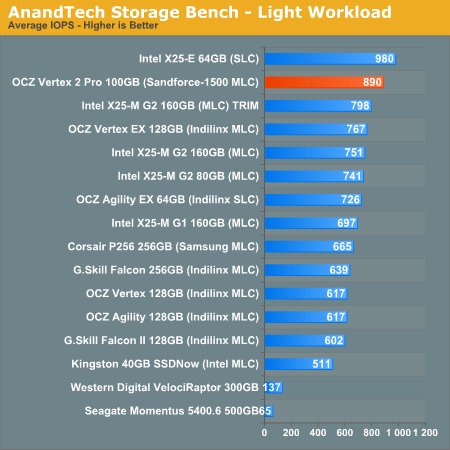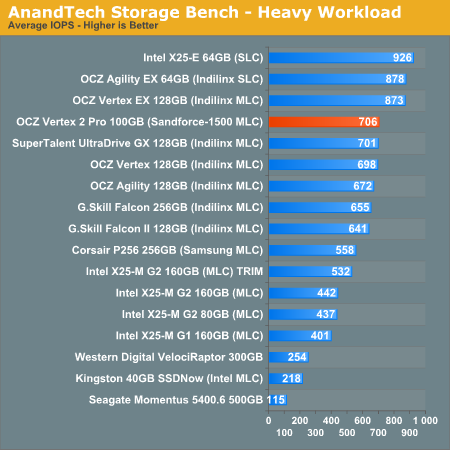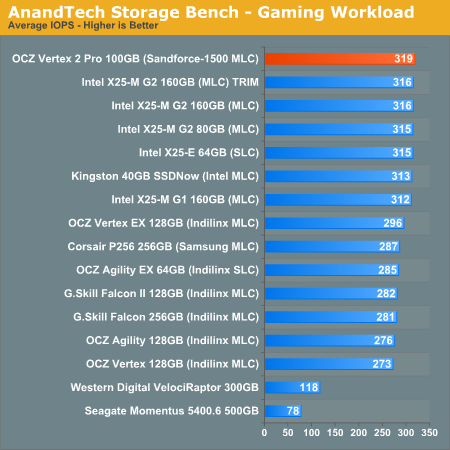OCZ's Vertex 2 Pro Preview: The Fastest MLC SSD We've Ever Tested
by Anand Lal Shimpi on December 31, 2009 12:00 AM EST- Posted in
- Storage
AnandTech Storage Bench
I introduced our storage suite in our last SSD article and it’s back, now with more data :)
Of the MLC SSDs represented here, there’s just nothing faster than the SandForce based OCZ Vertex 2 Pro.
Intel’s SLC based X25-E actually does very well, especially for a controller that’s as old as it is. It is worth noting however that the only thing separating Intel from SandForce-level performance is the X25-M’s low sequential write speed...
The first in our benchmark suite is a light usage case. The Windows 7 system is loaded with Firefox, Office 2007 and Adobe Reader among other applications. With Firefox we browse web pages like Facebook, AnandTech, Digg and other sites. Outlook is also running and we use it to check emails, create and send a message with a PDF attachment. Adobe Reader is used to view some PDFs. Excel 2007 is used to create a spreadsheet, graphs and save the document. The same goes for Word 2007. We open and step through a presentation in PowerPoint 2007 received as an email attachment before saving it to the desktop. Finally we watch a bit of a Firefly episode in Windows Media Player 11.
There’s some level of multitasking going on here but it’s not unreasonable by any means. Generally the application tasks proceed linearly, with the exception of things like web browsing which may happen in between one of the other tasks.
The recording is played back on all of our drives here today. Remember that we’re isolating disk performance, all we’re doing is playing back every single disk access that happened in that ~5 minute period of usage. The light workload is composed of 37,501 reads and 20,268 writes. Over 30% of the IOs are 4KB, 11% are 16KB, 22% are 32KB and approximately 13% are 64KB in size. Less than 30% of the operations are absolutely sequential in nature. Average queue depth is 6.09 IOs.
The performance results are reported in average I/O Operations per Second (IOPS):

If there’s a light usage case there’s bound to be a heavy one. In this test we have Microsoft Security Essentials running in the background with real time virus scanning enabled. We also perform a quick scan in the middle of the test. Firefox, Outlook, Excel, Word and Powerpoint are all used the same as they were in the light test. We add Photoshop CS4 to the mix, opening a bunch of 12MP images, editing them, then saving them as highly compressed JPGs for web publishing. Windows 7’s picture viewer is used to view a bunch of pictures on the hard drive. We use 7-zip to create and extract .7z archives. Downloading is also prominently featured in our heavy test; we download large files from the Internet during portions of the benchmark, as well as use uTorrent to grab a couple of torrents. Some of the applications in use are installed during the benchmark, Windows updates are also installed. Towards the end of the test we launch World of Warcraft, play for a few minutes, then delete the folder. This test also takes into account all of the disk accesses that happen while the OS is booting.
The benchmark is 22 minutes long and it consists of 128,895 read operations and 72,411 write operations. Roughly 44% of all IOs were sequential. Approximately 30% of all accesses were 4KB in size, 12% were 16KB in size, 14% were 32KB and 20% were 64KB. Average queue depth was 3.59.

Our final test focuses on actual gameplay in four 3D games: World of Warcraft, Batman: Arkham Asylum, FarCry 2 and Risen, in that order. The games are launched and played, altogether for a total of just under 30 minutes. The benchmark measures game load time, level load time, disk accesses from save games and normal data streaming during gameplay.
The gaming workload is made up of 75,206 read operations and only 4,592 write operations. Only 20% of the accesses are 4KB in size, nearly 40% are 64KB and 20% are 32KB. A whopping 69% of the IOs are sequential, meaning this is predominantly a sequential read benchmark. The average queue depth is 7.76 IOs.











100 Comments
View All Comments
semo - Saturday, January 2, 2010 - link
Anand,After reading your very informative SSD articles, I still found something new from GullLars. I think it would be useful to include the queue length when stating IOPS figures as it will give us more technical insight of the inner workings of the different SSD models and give hints to performance for future uses.
When dial up was the most common way of connecting to the internet, most sites were small with static content. As connection and CPU speeds grew, so did the websites. Try going to a big ugly site like cnet with a 7-8 year old pc with even the fastest internet connection. I'm sure that all this supposed untapped performance in SSDs will be quickly utilized in future (probably because of inefficient software in most cases rather than for legit reasons). With virtualization slowly entering the consumer space (XP mode, VM unity and so on) as giant sandboxes and legacy platforms, surely disk queue lengths can only grow...
shawkie - Saturday, January 2, 2010 - link
Anand,I agree that its also helpful to know what the hardware can really do. It seems to me that longer queue depths are becoming important for high performance on all storage devices (even hard disks have NCQ and can be put in RAID arrays). At some point software manufacturers are going to wake up to that fact. This is just like the situation with multi-core CPUs. I'm fortunate because in my work I not only select the hardware platform but also develop the software to run on it.
DominionSeraph - Monday, January 4, 2010 - link
A jumble of numbers that don't apply to the scenario at hand is nothing but misleading.Savvio 15K.1 SAS: 416 IOPS
1TB Caviar Black: 181.
Ooooh... the 15k SAS is waaaay faster!! Sure, in a file server access pattern at a queue depth of 64. Try benchmarking desktop use and you'll find the 7200RPM SATA is generally faster.
BrightCandle - Friday, January 1, 2010 - link
With which software and parameters did you achieve the results you are talking about? Everything I've thrown at my X25-M has shown results in the same park as Anand's figures so I'm interested to see how you got to those numbers.GullLars - Friday, January 1, 2010 - link
These numbers have been generated by several testing methods.*AS SSD benchmark shows 4KB random read and random write at Queue Depth (QD) 64, and x25-M gets in the area of 120-160MB/s on read and 65-85MB/s on write.
*Crystal Disk Mark 3.0 (beta) tests 4KB random at both QD1 and QD32. At QD32 4KB random read, Intel x25-M gets 120-160MB/s, and at random write it gets 65-85MB/s here too.
Here's to a screenshot of CDM 2.2 and 3.0 of x25-M 80GB on 750SB with AHCI in fresh state. http://www.diskusjon.no/index.php?act=attach&t...">http://www.diskusjon.no/index.php?act=attach&t...
*Testing with IOmeter, parameters 2GB length, 30 sec runtime, 1 worker, 32 outstanding IO's (QD), 100% read, 100% random, 4KB blocks, burst lenght 1. On a forum i frequent most users with x25-M get between 30-40.000 IOPS with theese parameters. For the same parameters only 100% write the norm is around 15K IOPS on a fresh drive, and a bit closer to 10K in used state with OS running from the drive. x25-E has been benched to 43K random write 4KB IOPS.
Regarding the practical difference 4KB IOPS makes, the biggest difference can be seen in the PCmark vantage test Application Launching. Such workloads involve reading a massive amount of small files and database listings, pluss logging all file access this creates. Prefetch and superfetch may help storage units with less than a few thousand IOPS, but x25-M in many cases actually get worse launch times with these activated. Using a RAM disk for known targets of small random writes make sense, and i've put my browser cache and temp files on a RAM disk even though i have an SSD.
With x25-M's insane IOPS performance, the random part of most workloads is done whitin a second and what you are left waiting for is the loading of larger files and the CPU. Attempting to lower the load time of small random reads during an application launch from say 0,5 sec by running a superfetch script or read-caching with a RAMdisk makes little sense.
Zool - Friday, January 1, 2010 - link
For a average user 4KB random performance are the most useless results out there. If a user encounters that much random 4KB read/writes than he need to change the operating system asap.And if something realy needs to randomly read/write 4KB files than your best bet is to cache it to Ram or make Ram disk i think.
LTG - Thursday, December 31, 2009 - link
This statement seems really dubious - Isn't it in fact the opposite?The majority of storage space is taken up by things that don't compress well: Music, Videos, Photos, Zip style archives...
Everything else is smaller.
Anand Says:
==========================
That means compressed images, videos or file archives will most likely exhibit higher write amplification than SandForce’s claimed 0.5x. Presumably that’s not the majority of writes your SSD will see on a day to day basis, but it’s going to be some portion of it.
DominionSeraph - Friday, January 1, 2010 - link
That stuff just gets written once.Day-to-day operations sees a whole lot of transient data.
Shining Arcanine - Thursday, December 31, 2009 - link
As someone else suggested, I imagine that the SATA driver could take all of the data written/read to the drive and transparently implement the algorithms on the much more powerful CPU.Is there anything to stop people from reverse engineering the firmware to figure out exactly what the drive in terms of compression is doing and then externalizing it to the SATA driver, so other SSDs can benefit from it as well? i.e. Are there any legal issues with this?
Anand Lal Shimpi - Friday, January 1, 2010 - link
Patents :) SandForce holds a few of them with regards to this technology.Obviously that's up to the courts to determine if they are enforceable or not, SandForce believes they are. Other companies could license the technology though...
Take care,
Anand